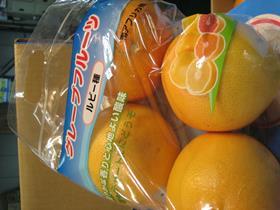
As South Africa starts its new citrus season the country’s Citrus Growers’ Association (CGA) has moved quickly to reassure growers about Japan, its most important grapefruit market, in the aftermath of the recent earthquake and tsunami.
“Japan is South Africa’s most important grapefruit market, absorbing a third of grapefruit exports,” said the CGA’s Justin Chadwick. “It seems that the major ports utilised by South Africa were not affected by the tsunami. However, the chaos to the north will put strain on Japan’s entire infrastructure. Our thoughts go out to all those caught up in the natural disaster in Japan, and its aftermath.”
He says Japan has always relied heavily on imported food, and the devastation wrought by the tsunami will mean an added reliance on imported food. “Reports out of Florida indicated restricted cancellation of grapefruit orders to date. The stocks of grapefruit in Japan, however, remain at 15-year lows.”
Mr Chadwick said initial plans will see the first shipment of South African grapefruit being sent during the third week of May, arriving in Japan in the first week of June. One other result of the earthquake is the fact that the strong South African currency has weakened by 10 per cent against the yen as Japan repatriates its funds from international markets.
As the end of March approaches, citrus growers across the country are still putting the finishing touches on their 2011 forecast. Due to hail in some regions and lower crops in others the forecast is expected to fall short on last year’s bumper crop.
At the end of last season the CGA announced export figures of 99m cartons, which fell just short of the magical mark of 100m for 2010 predicted some years ago.
“Comparing the 2008 shipped figures against 2010 and taking into account the lower volumes and disrupted markets in 2009, it is evident that exports are moving into newer markets,” Mr Chadwick said at the end of 2010.
Just what will happen in 2011 is still an open question, but this will depend very much on the total crop forecast. “At this early stage we are concerned about the effect of hail on the crop in some of the northern regions,” citrus industry expert Balie Wahl told Fruitnet.com. “The damage varies from area to area, but it will have an effect on the crop.”
The northern regions of South Africa produce the biggest percentage of the South African Valencia crop, last year contributing nearly 47 per cent of the overall volume. Prospects there will have a big influence on the forecast for 2011.
After the bumper 2010 season it is clear that different challenges will face South African citrus growers in 2011. Mr Chadwick has already warned growers that nothing less than their A-game will be enough. He said Northern Hemisphere production has recovered, particularly with respect to lemons and soft citrus, and prospects for other Southern Hemisphere production, such as lemons in Argentina, are also much better.
The CGA’s Mitchell Brooke explained the strengthening of the South African rand against the major fruit trading currencies continues to impact negatively on the returns to South African citrus growers. He also suggested there will be further pressure on growers’ bottom lines because of increased cost of production.
Logistics service providers have warned that the reefer bunker adjustment factor (BAFF) levels are now higher than during the previous oil crisis in 2008. This will all put extreme pressure on grower returns, with the instability in the Middle East region likely to add more fuel to the fire.
On the other hand, the South African citrus industry can look forward to the opening of the Thailand market for their products this season. It is hoped that all the formalities will be finalised before June this year and that the first fruit will be shipped this season.
Capespan spokesperson John Taillard said new market opportunities in India and Pakistan, together with greater penetration into markets of the Far East, is crucial to alleviating pressure on South Africa’s traditional markets. “Although the South African citrus harvest will probably not reach the heights of 2010, we are cautiously optimistic about the forecast for 2011.”






No comments yet